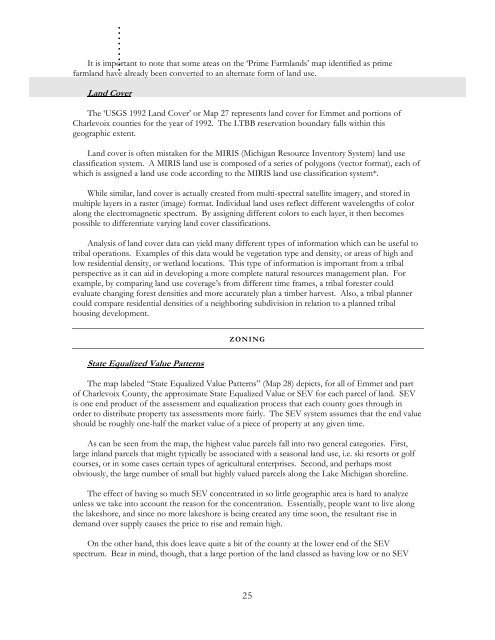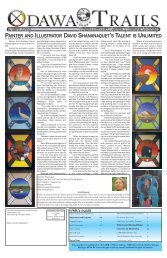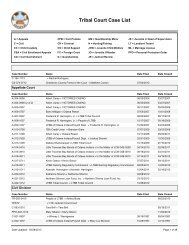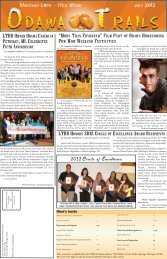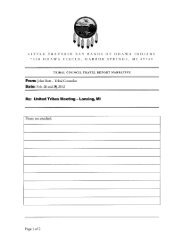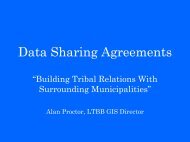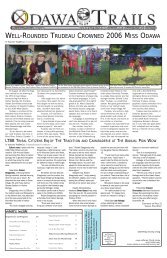LTBB Master Land Use Plan - Little Traverse Bay Bands of Odawa ...
LTBB Master Land Use Plan - Little Traverse Bay Bands of Odawa ...
LTBB Master Land Use Plan - Little Traverse Bay Bands of Odawa ...
Create successful ePaper yourself
Turn your PDF publications into a flip-book with our unique Google optimized e-Paper software.
.<br />
It is important to note that some areas on the ‘Prime Farmlands’ map identified as prime<br />
farmland have already been converted to an alternate form <strong>of</strong> land use.<br />
<strong>Land</strong> Cover<br />
The ‘USGS 1992 <strong>Land</strong> Cover’ or Map 27 represents land cover for Emmet and portions <strong>of</strong><br />
Charlevoix counties for the year <strong>of</strong> 1992. The <strong>LTBB</strong> reservation boundary falls within this<br />
geographic extent.<br />
<strong>Land</strong> cover is <strong>of</strong>ten mistaken for the MIRIS (Michigan Resource Inventory System) land use<br />
classification system. A MIRIS land use is composed <strong>of</strong> a series <strong>of</strong> polygons (vector format), each <strong>of</strong><br />
which is assigned a land use code according to the MIRIS land use classification system*.<br />
While similar, land cover is actually created from multi-spectral satellite imagery, and stored in<br />
multiple layers in a raster (image) format. Individual land uses reflect different wavelengths <strong>of</strong> color<br />
along the electromagnetic spectrum. By assigning different colors to each layer, it then becomes<br />
possible to differentiate varying land cover classifications.<br />
Analysis <strong>of</strong> land cover data can yield many different types <strong>of</strong> information which can be useful to<br />
tribal operations. Examples <strong>of</strong> this data would be vegetation type and density, or areas <strong>of</strong> high and<br />
low residential density, or wetland locations. This type <strong>of</strong> information is important from a tribal<br />
perspective as it can aid in developing a more complete natural resources management plan. For<br />
example, by comparing land use coverage’s from different time frames, a tribal forester could<br />
evaluate changing forest densities and more accurately plan a timber harvest. Also, a tribal planner<br />
could compare residential densities <strong>of</strong> a neighboring subdivision in relation to a planned tribal<br />
housing development.<br />
State Equalized Value Patterns<br />
ZONING<br />
The map labeled “State Equalized Value Patterns” (Map 28) depicts, for all <strong>of</strong> Emmet and part<br />
<strong>of</strong> Charlevoix County, the approximate State Equalized Value or SEV for each parcel <strong>of</strong> land. SEV<br />
is one end product <strong>of</strong> the assessment and equalization process that each county goes through in<br />
order to distribute property tax assessments more fairly. The SEV system assumes that the end value<br />
should be roughly one-half the market value <strong>of</strong> a piece <strong>of</strong> property at any given time.<br />
As can be seen from the map, the highest value parcels fall into two general categories. First,<br />
large inland parcels that might typically be associated with a seasonal land use, i.e. ski resorts or golf<br />
courses, or in some cases certain types <strong>of</strong> agricultural enterprises. Second, and perhaps most<br />
obviously, the large number <strong>of</strong> small but highly valued parcels along the Lake Michigan shoreline.<br />
The effect <strong>of</strong> having so much SEV concentrated in so little geographic area is hard to analyze<br />
unless we take into account the reason for the concentration. Essentially, people want to live along<br />
the lakeshore, and since no more lakeshore is being created any time soon, the resultant rise in<br />
demand over supply causes the price to rise and remain high.<br />
On the other hand, this does leave quite a bit <strong>of</strong> the county at the lower end <strong>of</strong> the SEV<br />
spectrum. Bear in mind, though, that a large portion <strong>of</strong> the land classed as having low or no SEV<br />
25


